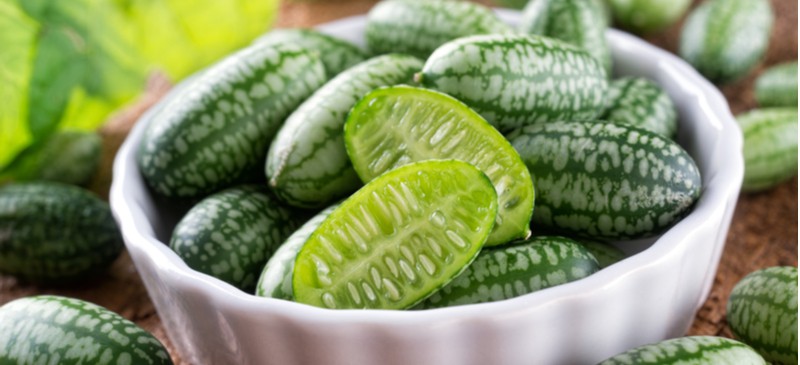
What would happen if you combined a watermelon with a grape? Turns out, we already know — cucamelon.
This tiny watermelon may be gaining recognition because of Instagram posts, but cucamelons offer much more than cute photographs.
Cucamelon is actually jam-packed with nutrients and can even be considered a superfood. You may have some trouble finding them in your local grocery store, but growing your own cucamelons at home is easy and provides month’s worth of nutrition and pleasant photos.
What Is a Cucamelon?
Cucamelon is the fruit of the Melothria Scabra vine and is a member of the Cucurbitaceae (cucumber) family. It goes by many names, including:
- mouse melon
- Mexican melon
- Mexican sour gherkin
- Mexican sour cucumber
- sandita, which means little watermelon in Spanish
This one-inch fruit looks like a mini watermelon, has the crunch of a cucumber and features a tangy, sour flavor. They grow to be about 1.25 inches long and 0.8 inches wide, and they have a thin but firm skin and a pleasant, juicy interior.
Nutrition Facts
It’s the nutrition content of cucamelon that makes it a superfood. The fruit contains:
- powerful antioxidants (including lycopene and beta-carotene)
- fiber
- vitamin C
- vitamin E
- vitamin K
- potassium
Not only are these tiny fruits nutrient-dense, but they are low in calories and offer a range of health benefits.
Health Benefits
1. Rich in Lycopene
Lycopene is a plant pigment with antioxidant effects. It gives fruits like watermelon, pink grapes and tomatoes their red-pink color.
The antioxidant is recognized for its ability to protect the body against oxidative stress, and studies indicate it has anti-inflammatory and brain-boosting properties.
In fact, one study published in the Journal of Nutritional Science found that there’s a significant association between lower circulating lycopene and higher rates of Alzheimer’s disease mortality.
Research also suggests that lycopene consumption may positively affect cancer or cardiovascular disease risk.
2. Features Beta-Carotene
Beta-carotene is a type of carotenoid that’s found in fruits and works as another powerful antioxidant. It’s converted to vitamin A in the body, which plays a critical role in neurological function, healthy vision and skin health.
The beta-carotene in cucamelons protect the body from oxidative stress that causes cellular changes and disease. In fact, a meta-analysis published in Scientific Reports suggests that high beta-carotene levels in serum or plasma is associated with a significantly lower risk of all-cause mortality.
3. Provides Fiber
The skin of cucamelon fruits are high in fiber, adding to the nutritional value. The type of fiber found in fruit peels, like that of cucamelon, is viscous (or soluble) fiber that becomes thicker when consumed and turns into a gel-like substance.
This is beneficial because it makes you feel full faster and longer. Because of this, eating cucamelon and other fibrous fruits may allow you to feel full from fewer calories and prevent you from reaching for another snack a short time later.
On top of that, studies show that consuming viscous soluble fiber has an overall lowering effect on blood pressure and may reduce the risk fo cardiovascular disease.
READ RELATED: What Is Quark Cheese? Nutrition, Benefits & How to Make It
4. Good Source of Potassium
Potassium is an essential nutrient that’s beneficial and critical to the body for several reasons. It’s required for the function of several organs, including the brain, heart and kidneys.
It also plays an important role in keeping the body hydrated.
Research highlights how increasing potassium intake has beneficial effects on human health, including its ability to reduce the risk of cardiovascular disease mortality.
5. Boosts Immune Function
Cucamelons are rich in vitamin C, which acts as an antioxidant to neutralize free radials, reduce inflammation and boost immune function.
Several studies evaluating vitamin C’s immune-boosting benefits show that it may reduce the frequency and duration of respiratory infections and works as the body’s first line of defense against foreign pathogens.
How to Eat (Plus Recipes)
Cucamelons are eaten raw and added to dishes or sides that benefit from a tangy, sour flavor. They are commonly added to salsas and salads.
Cucamelons can also be pickled, just like cucumbers.
Here are some cucamelon recipe ideas:
- Add it to salad: The fruit mixes well with cherry tomatoes, sweet peppers, leafy greens and fresh herbs, like basil and parsley.
- Pickle them: Add the fruit to a jar with apple cider vinegar, salt and water. You can add flavors like fresh dill, chili peppers and mustard seeds.
- Make a salsa: Cucamelon is a great addition to salsa and can even take the place of tomatoes, making it less acidic.
How to Grow Cucamelons
To grow cucamelon, you need plenty of sun and plenty of time. They are slow to germinate and grow, so it’s often recommended to start growing the fruit indoors and then transfer them to your outdoor gardens when the seedlings have hardened.
When starting cucamelon from seeds, be sure to keep the soil moist and above 70 degrees Fahrenheit. It can take two weeks for the seeds to germinate.
Once the seedlings have emerged and hardened, which can take three to five weeks, it’s time to transplant them to the garden. Make sure that you choose a sunny spot, and there’s no risk of frost.
What do cucamelon plants need to flourish in your garden?
- 16 hours of sunlight as seedlings and 6–8 hours of direct sunlight once planted
- moist, well-drained soil
- water right at the soil or with drip irrigation
- warm temperatures
Once the fruits grow, cut them off the vine before enjoying. They can be kept in the refrigerator for a few days.
Risks and Side Effects
Eating cucamelons in normal food amounts is safe. If you notice any allergy symptoms following consumption, like rash, throat tightness or trouble breathing, then avoid eating this fruit and seek medical care if needed.
This, however, is rare.
If you are growing your own cucamelons, be careful not to spray any chemicals around the area. Also, if you are pickling the fruit, make sure you are using sterile equipment to ensure that the jar doesn’t become contaminated during the fermentation process.
Conclusion
- Cucamelons are part of the cucumber family, but they look like mini watermelons.
- These fruits are packed with nutrients, including powerful antioxidants. They are considered a superfood because of their many health benefits.
- It can be hard to find these fruits in your local grocery store, but you can grow them in your own garden.
- Cucamelons can be eaten raw and added to salads and salsas. They can also be pickled, just like cucumbers.
Source: Dr. Axe | Nutrition






